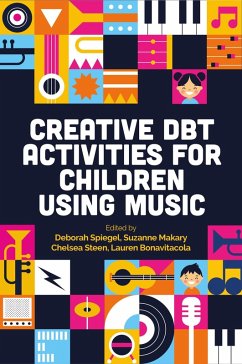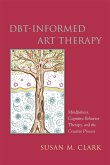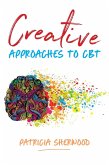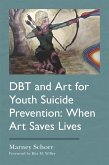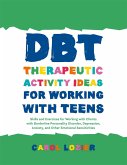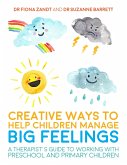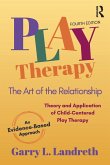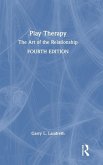Various Authors
Creative Dbt Activities for Children Using Music
Herausgeber: Spiegel, Deborah; Steen, Chelsea; Makary, Suzanne; Bonavitacola, Lauren
Various Authors
Creative Dbt Activities for Children Using Music
Herausgeber: Spiegel, Deborah; Steen, Chelsea; Makary, Suzanne; Bonavitacola, Lauren
- Broschiertes Buch
- Merkliste
- Auf die Merkliste
- Bewerten Bewerten
- Teilen
- Produkt teilen
- Produkterinnerung
- Produkterinnerung
Musical DBT-informed activities that equip educators, therapists, and parents with tools to reach the social and emotional needs of children through fresh and creative activities.
Andere Kunden interessierten sich auch für
![Dbt-Informed Art Therapy Dbt-Informed Art Therapy]() Susan M. ClarkDbt-Informed Art Therapy47,99 €
Susan M. ClarkDbt-Informed Art Therapy47,99 €![Creative Approaches to CBT Creative Approaches to CBT]() Patricia SherwoodCreative Approaches to CBT31,99 €
Patricia SherwoodCreative Approaches to CBT31,99 €![Dbt and Art for Youth Suicide Prevention Dbt and Art for Youth Suicide Prevention]() Marney SchorrDbt and Art for Youth Suicide Prevention37,99 €
Marney SchorrDbt and Art for Youth Suicide Prevention37,99 €![Dbt Therapeutic Activity Ideas for Working with Teens Dbt Therapeutic Activity Ideas for Working with Teens]() Carol LozierDbt Therapeutic Activity Ideas for Working with Teens42,99 €
Carol LozierDbt Therapeutic Activity Ideas for Working with Teens42,99 €![Creative Ways to Help Children Manage Big Feelings Creative Ways to Help Children Manage Big Feelings]() Fiona ZandtCreative Ways to Help Children Manage Big Feelings42,99 €
Fiona ZandtCreative Ways to Help Children Manage Big Feelings42,99 €![Play Therapy Play Therapy]() Garry L. LandrethPlay Therapy56,99 €
Garry L. LandrethPlay Therapy56,99 €![Play Therapy Play Therapy]() Garry L. LandrethPlay Therapy170,99 €
Garry L. LandrethPlay Therapy170,99 €-
-
-
Musical DBT-informed activities that equip educators, therapists, and parents with tools to reach the social and emotional needs of children through fresh and creative activities.
Produktdetails
- Produktdetails
- Verlag: Jessica Kingsley Publishers
- Illustrated ed
- Seitenzahl: 224
- Erscheinungstermin: 21. November 2025
- Englisch
- Abmessung: 229mm x 153mm x 12mm
- Gewicht: 334g
- ISBN-13: 9781805013211
- ISBN-10: 1805013211
- Artikelnr.: 71572362
- Herstellerkennzeichnung
- Libri GmbH
- Europaallee 1
- 36244 Bad Hersfeld
- gpsr@libri.de
- Verlag: Jessica Kingsley Publishers
- Illustrated ed
- Seitenzahl: 224
- Erscheinungstermin: 21. November 2025
- Englisch
- Abmessung: 229mm x 153mm x 12mm
- Gewicht: 334g
- ISBN-13: 9781805013211
- ISBN-10: 1805013211
- Artikelnr.: 71572362
- Herstellerkennzeichnung
- Libri GmbH
- Europaallee 1
- 36244 Bad Hersfeld
- gpsr@libri.de
Edited by Deborah Spiegel, Suzanne Makary, Chelsea Steen, Lauren Bonavitacola. Foreword by Alycia Dadd
Foreword
I. Introduction
A. Explanation of DBT and how it can be used to help children
B. Overview of how music can be incorporated into DBT activities
C. How to use this book
II. Principles of Dialectics
A. Explanation of dialectics, its importance in DBT
B. Music activities for teaching the concept of dialectics to children
Dialectics: Opposites
Change: Move My Statue
Truth in Different Interpretations: Draw and Describe
III. Mindfulness
A. Explanation of mindfulness, its importance in DBT
B. Music activities for teaching mindfulness skills to children
General Mindfulness: Mindfulness
Wise Mind: Musical States of Mind
What skills/Observe: Notice my Breath
What Skill/ Observe: Catch the Breath
What Skill/ Observe: Rainbow
What Skill/ Observe: Use My Senses
What Skill/ Describe: The Train
What Skill/ Participate: I Like the Flowers
What Skill/ Participate: Listen for the Word
What Skill/ Observe, Describe, Participate: Name That Instrument
What Skill/ Observe, Describe, Participate: Song Listening
How Skill/Stay Focused: Dance it Out
How Skill/ Stay Focused: Musical Workout
How Skill/ Don't Judge: Row Row Fact or Foe
How Skill/ Do What Works: New Moves
Mindfulness Review: Wise Mind, What Skills: Roller Coaster Ride
Mindfulness Review: Participate, Don't Judge, Do What Works: Loving
Kindness
All Mindfulness Skills: Mindfulness Monsters
IV. Distress Tolerance
A. Explanation of distress tolerance and its importance in DBT
B. Music activities for teaching distress tolerance skills to children
STOP: Healthy Choices Freeze Dance
STOP: Stop and Sing
STOP: Shake Don't Shout
Wise Mind ACCEPTS/Activities: Favorites
Wise Mind ACCEPTS/ Contributing: Help One Another
Wise Mind ACCEPTS/ Comparison: Colors
Wise Mind ACCEPTS/with other EmotionsMusic to Change My Mood
Wise Mind ACCEPTS/Push Away: Lock and Key
Wise Mind ACCEPTS/with other Thoughts: Changing Our Thoughts
Wise Mind ACCEPTS/Senses: Shocking Senses
IMPROVE the moment/Imagery: Create Your World
IMPROVE the moment/ Meaning: Rainy Days
IMPROVE the moment/Prayer: Reflections
IMPROVE the moment/Relaxing Actions: How I Relax
IMPROVE the moment/One Thing in the Moment: One Moment Please
IMPROVE the moment/Vacation: Vacation Spots
IMPROVE the moment/Encouragement: I Know I Can
IMPROVE the moment/ Self-Encouragement: It is Me
TIP: Tea Pot Tip
TIP: Grizzly Bear Grump
TIP: Breathe
Self Soothe: Calming Senses, Big Emotions
Pros & Cons: Pros & Cons Song
Radical Acceptance: The Acceptance Tree
Radical Acceptance: Turn the Mind
Radical Acceptance/Willingness and Willing Hands: Willing to Try
V. Emotion Regulation
A. Explanation of emotion regulation and its importance in DBT
B. Music activities for teaching emotion regulation skills to children
Functions of Emotions: What Do My Emotions Do
Understanding Emotions: Name My Emotions
Understanding Emotions: Musical Chairs Meet My Feelings
Understanding Emotions: My Body My Emotions
Changing Emotions/Checking the Facts: Checking the Facts
Changing Emotions/ Opposite Action: Act Opposite
Changing Emotions/ Problem Solving: I've Been Working on a Problem
Decreasing vulnerabilities/ Accumulating Positives: Find the Fun!
Decreasing vulnerabilities/ Accumulating Positive Experiences in the Long
Term: Make New Friends
Decreasing vulnerabilities/ Building Mastery: Cups & Claps
Decreasing vulnerabilities/Cope Ahead: I Think I Can
Decreasing vulnerabilities/ PLEASE : I'm Going on a Picnic
Decreasing vulnerabilities/ ABC: ABC Skills Review
Decreasing vulnerabilities/ Mindfulness of Current Emotions -The Wave
Skill: Ride the Wave
VI. Interpersonal Effectiveness
A. Explanation of interpersonal effectiveness and its importance in DBT
B. Music activities for teaching interpersonal effectiveness skills to
children
DEARMAN/ Entire skill: Dearman song
DEARMAN/Describe: Describe
DEARMAN/Express and Assert/ask: Stop Friend
DEARMAN/Reinforce: Reinforce, Thank you
GIVE/Gentle: G is for Gentle
GIVE/Act Interested: Act Interested
GIVE/ Validate: Active Listening
GIVE/ Easy Manner: Easy Expressions
FAST: Fast Friends
VII. Using Music to Reinforce DBT Skills at Home
VIII. Conclusion
A. Summary of key takeaways from the book
B. Additional resources for further study and implementation of music-based
DBT activities for children.
I. Introduction
A. Explanation of DBT and how it can be used to help children
B. Overview of how music can be incorporated into DBT activities
C. How to use this book
II. Principles of Dialectics
A. Explanation of dialectics, its importance in DBT
B. Music activities for teaching the concept of dialectics to children
Dialectics: Opposites
Change: Move My Statue
Truth in Different Interpretations: Draw and Describe
III. Mindfulness
A. Explanation of mindfulness, its importance in DBT
B. Music activities for teaching mindfulness skills to children
General Mindfulness: Mindfulness
Wise Mind: Musical States of Mind
What skills/Observe: Notice my Breath
What Skill/ Observe: Catch the Breath
What Skill/ Observe: Rainbow
What Skill/ Observe: Use My Senses
What Skill/ Describe: The Train
What Skill/ Participate: I Like the Flowers
What Skill/ Participate: Listen for the Word
What Skill/ Observe, Describe, Participate: Name That Instrument
What Skill/ Observe, Describe, Participate: Song Listening
How Skill/Stay Focused: Dance it Out
How Skill/ Stay Focused: Musical Workout
How Skill/ Don't Judge: Row Row Fact or Foe
How Skill/ Do What Works: New Moves
Mindfulness Review: Wise Mind, What Skills: Roller Coaster Ride
Mindfulness Review: Participate, Don't Judge, Do What Works: Loving
Kindness
All Mindfulness Skills: Mindfulness Monsters
IV. Distress Tolerance
A. Explanation of distress tolerance and its importance in DBT
B. Music activities for teaching distress tolerance skills to children
STOP: Healthy Choices Freeze Dance
STOP: Stop and Sing
STOP: Shake Don't Shout
Wise Mind ACCEPTS/Activities: Favorites
Wise Mind ACCEPTS/ Contributing: Help One Another
Wise Mind ACCEPTS/ Comparison: Colors
Wise Mind ACCEPTS/with other EmotionsMusic to Change My Mood
Wise Mind ACCEPTS/Push Away: Lock and Key
Wise Mind ACCEPTS/with other Thoughts: Changing Our Thoughts
Wise Mind ACCEPTS/Senses: Shocking Senses
IMPROVE the moment/Imagery: Create Your World
IMPROVE the moment/ Meaning: Rainy Days
IMPROVE the moment/Prayer: Reflections
IMPROVE the moment/Relaxing Actions: How I Relax
IMPROVE the moment/One Thing in the Moment: One Moment Please
IMPROVE the moment/Vacation: Vacation Spots
IMPROVE the moment/Encouragement: I Know I Can
IMPROVE the moment/ Self-Encouragement: It is Me
TIP: Tea Pot Tip
TIP: Grizzly Bear Grump
TIP: Breathe
Self Soothe: Calming Senses, Big Emotions
Pros & Cons: Pros & Cons Song
Radical Acceptance: The Acceptance Tree
Radical Acceptance: Turn the Mind
Radical Acceptance/Willingness and Willing Hands: Willing to Try
V. Emotion Regulation
A. Explanation of emotion regulation and its importance in DBT
B. Music activities for teaching emotion regulation skills to children
Functions of Emotions: What Do My Emotions Do
Understanding Emotions: Name My Emotions
Understanding Emotions: Musical Chairs Meet My Feelings
Understanding Emotions: My Body My Emotions
Changing Emotions/Checking the Facts: Checking the Facts
Changing Emotions/ Opposite Action: Act Opposite
Changing Emotions/ Problem Solving: I've Been Working on a Problem
Decreasing vulnerabilities/ Accumulating Positives: Find the Fun!
Decreasing vulnerabilities/ Accumulating Positive Experiences in the Long
Term: Make New Friends
Decreasing vulnerabilities/ Building Mastery: Cups & Claps
Decreasing vulnerabilities/Cope Ahead: I Think I Can
Decreasing vulnerabilities/ PLEASE : I'm Going on a Picnic
Decreasing vulnerabilities/ ABC: ABC Skills Review
Decreasing vulnerabilities/ Mindfulness of Current Emotions -The Wave
Skill: Ride the Wave
VI. Interpersonal Effectiveness
A. Explanation of interpersonal effectiveness and its importance in DBT
B. Music activities for teaching interpersonal effectiveness skills to
children
DEARMAN/ Entire skill: Dearman song
DEARMAN/Describe: Describe
DEARMAN/Express and Assert/ask: Stop Friend
DEARMAN/Reinforce: Reinforce, Thank you
GIVE/Gentle: G is for Gentle
GIVE/Act Interested: Act Interested
GIVE/ Validate: Active Listening
GIVE/ Easy Manner: Easy Expressions
FAST: Fast Friends
VII. Using Music to Reinforce DBT Skills at Home
VIII. Conclusion
A. Summary of key takeaways from the book
B. Additional resources for further study and implementation of music-based
DBT activities for children.
Foreword
I. Introduction
A. Explanation of DBT and how it can be used to help children
B. Overview of how music can be incorporated into DBT activities
C. How to use this book
II. Principles of Dialectics
A. Explanation of dialectics, its importance in DBT
B. Music activities for teaching the concept of dialectics to children
Dialectics: Opposites
Change: Move My Statue
Truth in Different Interpretations: Draw and Describe
III. Mindfulness
A. Explanation of mindfulness, its importance in DBT
B. Music activities for teaching mindfulness skills to children
General Mindfulness: Mindfulness
Wise Mind: Musical States of Mind
What skills/Observe: Notice my Breath
What Skill/ Observe: Catch the Breath
What Skill/ Observe: Rainbow
What Skill/ Observe: Use My Senses
What Skill/ Describe: The Train
What Skill/ Participate: I Like the Flowers
What Skill/ Participate: Listen for the Word
What Skill/ Observe, Describe, Participate: Name That Instrument
What Skill/ Observe, Describe, Participate: Song Listening
How Skill/Stay Focused: Dance it Out
How Skill/ Stay Focused: Musical Workout
How Skill/ Don't Judge: Row Row Fact or Foe
How Skill/ Do What Works: New Moves
Mindfulness Review: Wise Mind, What Skills: Roller Coaster Ride
Mindfulness Review: Participate, Don't Judge, Do What Works: Loving
Kindness
All Mindfulness Skills: Mindfulness Monsters
IV. Distress Tolerance
A. Explanation of distress tolerance and its importance in DBT
B. Music activities for teaching distress tolerance skills to children
STOP: Healthy Choices Freeze Dance
STOP: Stop and Sing
STOP: Shake Don't Shout
Wise Mind ACCEPTS/Activities: Favorites
Wise Mind ACCEPTS/ Contributing: Help One Another
Wise Mind ACCEPTS/ Comparison: Colors
Wise Mind ACCEPTS/with other EmotionsMusic to Change My Mood
Wise Mind ACCEPTS/Push Away: Lock and Key
Wise Mind ACCEPTS/with other Thoughts: Changing Our Thoughts
Wise Mind ACCEPTS/Senses: Shocking Senses
IMPROVE the moment/Imagery: Create Your World
IMPROVE the moment/ Meaning: Rainy Days
IMPROVE the moment/Prayer: Reflections
IMPROVE the moment/Relaxing Actions: How I Relax
IMPROVE the moment/One Thing in the Moment: One Moment Please
IMPROVE the moment/Vacation: Vacation Spots
IMPROVE the moment/Encouragement: I Know I Can
IMPROVE the moment/ Self-Encouragement: It is Me
TIP: Tea Pot Tip
TIP: Grizzly Bear Grump
TIP: Breathe
Self Soothe: Calming Senses, Big Emotions
Pros & Cons: Pros & Cons Song
Radical Acceptance: The Acceptance Tree
Radical Acceptance: Turn the Mind
Radical Acceptance/Willingness and Willing Hands: Willing to Try
V. Emotion Regulation
A. Explanation of emotion regulation and its importance in DBT
B. Music activities for teaching emotion regulation skills to children
Functions of Emotions: What Do My Emotions Do
Understanding Emotions: Name My Emotions
Understanding Emotions: Musical Chairs Meet My Feelings
Understanding Emotions: My Body My Emotions
Changing Emotions/Checking the Facts: Checking the Facts
Changing Emotions/ Opposite Action: Act Opposite
Changing Emotions/ Problem Solving: I've Been Working on a Problem
Decreasing vulnerabilities/ Accumulating Positives: Find the Fun!
Decreasing vulnerabilities/ Accumulating Positive Experiences in the Long
Term: Make New Friends
Decreasing vulnerabilities/ Building Mastery: Cups & Claps
Decreasing vulnerabilities/Cope Ahead: I Think I Can
Decreasing vulnerabilities/ PLEASE : I'm Going on a Picnic
Decreasing vulnerabilities/ ABC: ABC Skills Review
Decreasing vulnerabilities/ Mindfulness of Current Emotions -The Wave
Skill: Ride the Wave
VI. Interpersonal Effectiveness
A. Explanation of interpersonal effectiveness and its importance in DBT
B. Music activities for teaching interpersonal effectiveness skills to
children
DEARMAN/ Entire skill: Dearman song
DEARMAN/Describe: Describe
DEARMAN/Express and Assert/ask: Stop Friend
DEARMAN/Reinforce: Reinforce, Thank you
GIVE/Gentle: G is for Gentle
GIVE/Act Interested: Act Interested
GIVE/ Validate: Active Listening
GIVE/ Easy Manner: Easy Expressions
FAST: Fast Friends
VII. Using Music to Reinforce DBT Skills at Home
VIII. Conclusion
A. Summary of key takeaways from the book
B. Additional resources for further study and implementation of music-based
DBT activities for children.
I. Introduction
A. Explanation of DBT and how it can be used to help children
B. Overview of how music can be incorporated into DBT activities
C. How to use this book
II. Principles of Dialectics
A. Explanation of dialectics, its importance in DBT
B. Music activities for teaching the concept of dialectics to children
Dialectics: Opposites
Change: Move My Statue
Truth in Different Interpretations: Draw and Describe
III. Mindfulness
A. Explanation of mindfulness, its importance in DBT
B. Music activities for teaching mindfulness skills to children
General Mindfulness: Mindfulness
Wise Mind: Musical States of Mind
What skills/Observe: Notice my Breath
What Skill/ Observe: Catch the Breath
What Skill/ Observe: Rainbow
What Skill/ Observe: Use My Senses
What Skill/ Describe: The Train
What Skill/ Participate: I Like the Flowers
What Skill/ Participate: Listen for the Word
What Skill/ Observe, Describe, Participate: Name That Instrument
What Skill/ Observe, Describe, Participate: Song Listening
How Skill/Stay Focused: Dance it Out
How Skill/ Stay Focused: Musical Workout
How Skill/ Don't Judge: Row Row Fact or Foe
How Skill/ Do What Works: New Moves
Mindfulness Review: Wise Mind, What Skills: Roller Coaster Ride
Mindfulness Review: Participate, Don't Judge, Do What Works: Loving
Kindness
All Mindfulness Skills: Mindfulness Monsters
IV. Distress Tolerance
A. Explanation of distress tolerance and its importance in DBT
B. Music activities for teaching distress tolerance skills to children
STOP: Healthy Choices Freeze Dance
STOP: Stop and Sing
STOP: Shake Don't Shout
Wise Mind ACCEPTS/Activities: Favorites
Wise Mind ACCEPTS/ Contributing: Help One Another
Wise Mind ACCEPTS/ Comparison: Colors
Wise Mind ACCEPTS/with other EmotionsMusic to Change My Mood
Wise Mind ACCEPTS/Push Away: Lock and Key
Wise Mind ACCEPTS/with other Thoughts: Changing Our Thoughts
Wise Mind ACCEPTS/Senses: Shocking Senses
IMPROVE the moment/Imagery: Create Your World
IMPROVE the moment/ Meaning: Rainy Days
IMPROVE the moment/Prayer: Reflections
IMPROVE the moment/Relaxing Actions: How I Relax
IMPROVE the moment/One Thing in the Moment: One Moment Please
IMPROVE the moment/Vacation: Vacation Spots
IMPROVE the moment/Encouragement: I Know I Can
IMPROVE the moment/ Self-Encouragement: It is Me
TIP: Tea Pot Tip
TIP: Grizzly Bear Grump
TIP: Breathe
Self Soothe: Calming Senses, Big Emotions
Pros & Cons: Pros & Cons Song
Radical Acceptance: The Acceptance Tree
Radical Acceptance: Turn the Mind
Radical Acceptance/Willingness and Willing Hands: Willing to Try
V. Emotion Regulation
A. Explanation of emotion regulation and its importance in DBT
B. Music activities for teaching emotion regulation skills to children
Functions of Emotions: What Do My Emotions Do
Understanding Emotions: Name My Emotions
Understanding Emotions: Musical Chairs Meet My Feelings
Understanding Emotions: My Body My Emotions
Changing Emotions/Checking the Facts: Checking the Facts
Changing Emotions/ Opposite Action: Act Opposite
Changing Emotions/ Problem Solving: I've Been Working on a Problem
Decreasing vulnerabilities/ Accumulating Positives: Find the Fun!
Decreasing vulnerabilities/ Accumulating Positive Experiences in the Long
Term: Make New Friends
Decreasing vulnerabilities/ Building Mastery: Cups & Claps
Decreasing vulnerabilities/Cope Ahead: I Think I Can
Decreasing vulnerabilities/ PLEASE : I'm Going on a Picnic
Decreasing vulnerabilities/ ABC: ABC Skills Review
Decreasing vulnerabilities/ Mindfulness of Current Emotions -The Wave
Skill: Ride the Wave
VI. Interpersonal Effectiveness
A. Explanation of interpersonal effectiveness and its importance in DBT
B. Music activities for teaching interpersonal effectiveness skills to
children
DEARMAN/ Entire skill: Dearman song
DEARMAN/Describe: Describe
DEARMAN/Express and Assert/ask: Stop Friend
DEARMAN/Reinforce: Reinforce, Thank you
GIVE/Gentle: G is for Gentle
GIVE/Act Interested: Act Interested
GIVE/ Validate: Active Listening
GIVE/ Easy Manner: Easy Expressions
FAST: Fast Friends
VII. Using Music to Reinforce DBT Skills at Home
VIII. Conclusion
A. Summary of key takeaways from the book
B. Additional resources for further study and implementation of music-based
DBT activities for children.

